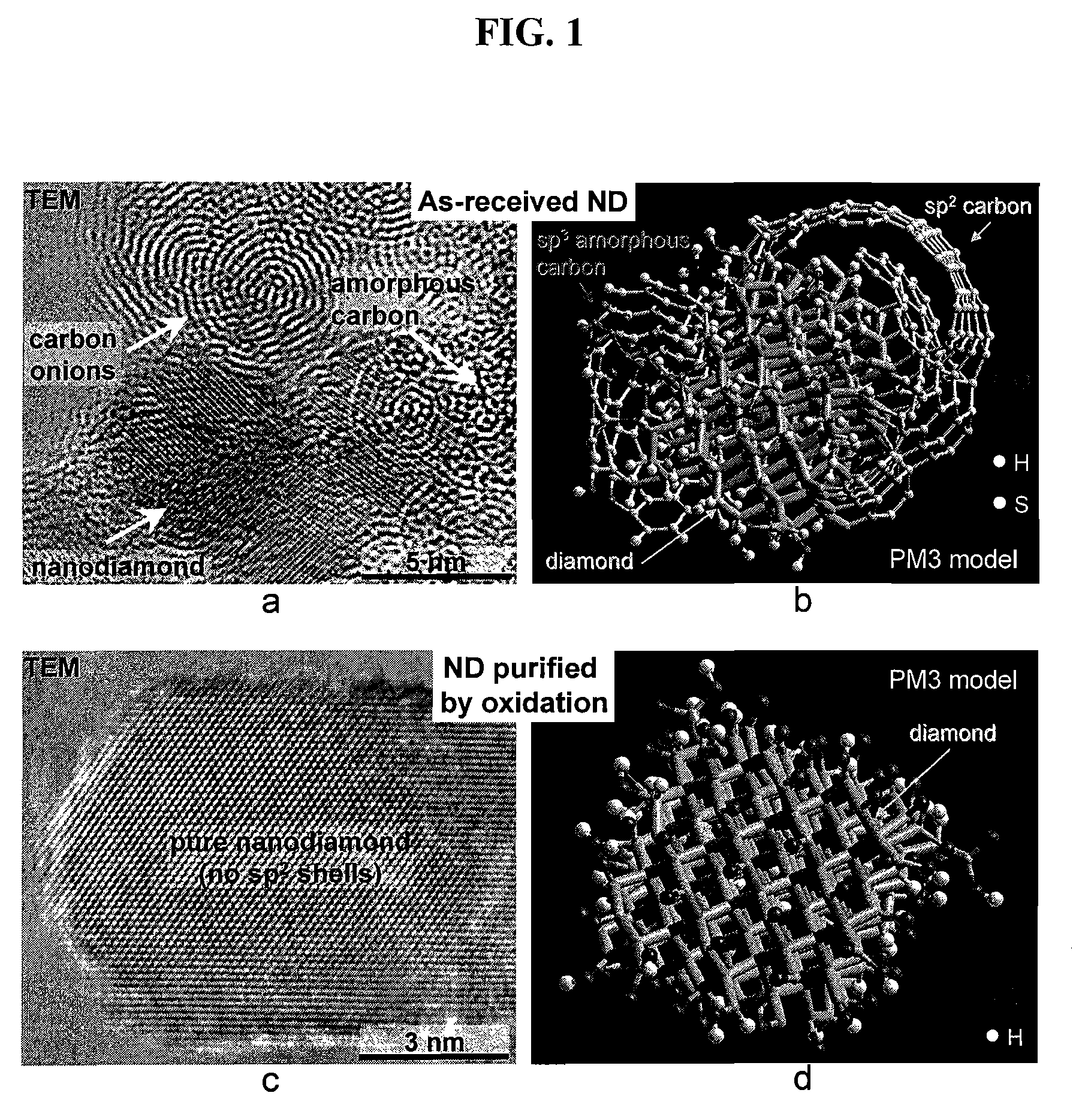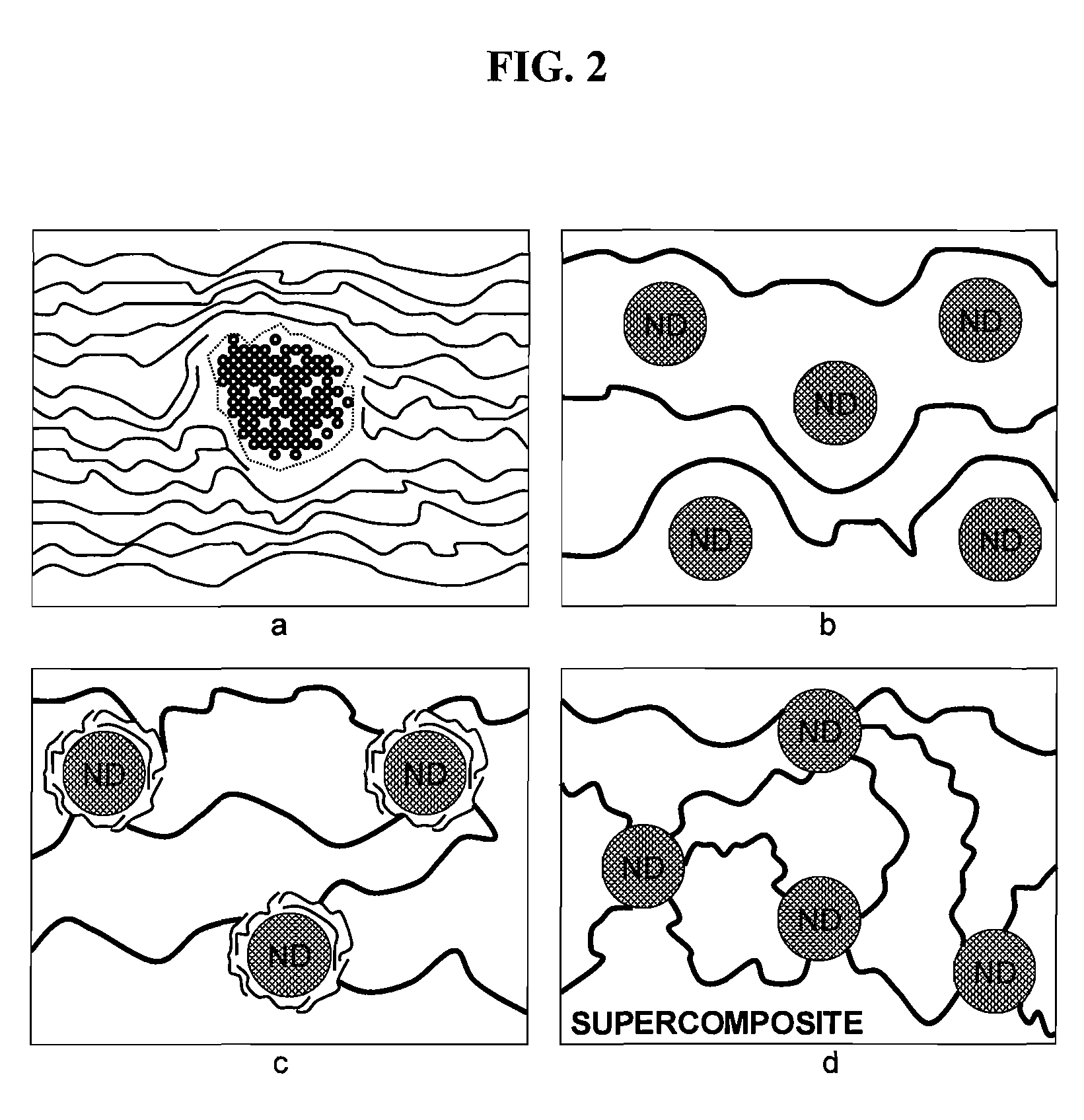Functionalized Nanodiamond Reinforced Biopolymers
a biopolymer and nano-diamond technology, applied in the direction of ligaments, prostheses, osteosynthesis devices, etc., can solve the problems of biocompatible polymer-based fixation devices, cavitations in the bone, and metal implant devices that are not degradabl
- Summary
- Abstract
- Description
- Claims
- Application Information
AI Technical Summary
Problems solved by technology
Method used
Image
Examples
example 1
Preparation and Characterization of Derivatized ND Particles
[0153]30 mg of ND, corresponding to compound 1 in reaction (IV) (UD90 grade, NanoBlox, Inc., USA), was purified by air oxidation and cleansed of metal impurities by boiling in 35% wt HCl for 24 hours, and then refluxed with 50 mL of SOCl2 (Sigma Aldrich) and 1 mL of anhydrous N,N-dimethylformamide (DMF) (Sigma Aldrich), a well known catalyst for this reaction, at 70° C. for 24 h.
[0154]After removing the brown-colored liquid, compound 2 in reaction (IV) was washed with anhydrous tetrahydrofuran twice, and then dried at ambient temperature in a desiccator under vacuum. About 30 mg of the acyl chloride derivative 2 was stirred in a sealed flask with 1 g of octadecylamine, also known as ODA (Sigma Aldrich), at 90-100° C. for 96 hours. After cooling, excess ODA was removed by sonication with anhydrous methanol (Sigma Aldrich) 4-5 times. To remove adsorbed ODA, the material 3 in reaction (IV) was further purified by extraction wi...
example 2
Dispersion of Non-Functionalized and Surface-Functionalized NDs in PLLA
[0160]Due to the long hydrocarbon chains linked to its surface, the ND-ODA could be easily dispersed in hydrophobic solvents such as benzene, toluene, chloroform, and dichloromethane. At the same time, it was immiscible with water and poorly miscible with hydrophilic organic solvents such as DMF, ethanol, methanol, and acetone.
[0161]After being dispersed in toluene with ultrasonication, NDs completely precipitated within 1 hour (FIG. 9). On the other hand, ND-ODA without any sonication or other means formed a clear, stable pale yellowish (or brown at high concentrations) colloidal solution, which showed no visible precipitation over a week. Particle size measurements revealed 100-300 nm ND-ODA agglomerates in toluene and chloroform (FIG. 9) in contrast to 5,000-9,000 nm agglomerates formed in DMF. No sonication, surfactants, or other special means of dispersing were necessary for ND-ODA. The solubility of ND-ODA,...
example 3
Mechanical Tests in PLLA
[0166]Results were produced on PLLA with two kinds of ND powders: air-oxidized HCl-purified ND, and hydrophobic ND terminated with long aliphatic chains of octadecylamine (ODA) (Mochalin et al., “High temperature functionalization and surface modification of nanodiamond powders,” In “Materials Research Society Symposium Proceedings Boston,” MA, USA, 2007, Vol. 1039, 1039-P11-03). The hardness tests were performed on a Wilson Rockwell Hardness Tester (Instron Worldwide Headquarters, Norwood, Mass.).
[0167]FIG. 11 depicts the hardness of the composites produced with ND and ND-ODA. The hardness increased about 2 times when adding 0.5% wt. of air oxidized HCl purified ND into PLLA. However, it decreased when adding more air oxidized HCl purified ND (1% wt) into the biopolymer. This behavior is similar to results of d'Almeida et al. (J. Reinf. Plast. Comp., 2007, 26(3), 321-330) and is due to a poor dispersion of the purified but non-functionalized ND in the polyme...
PUM
| Property | Measurement | Unit |
|---|---|---|
| Fraction | aaaaa | aaaaa |
| Fraction | aaaaa | aaaaa |
| Length | aaaaa | aaaaa |
Abstract
Description
Claims
Application Information
 Login to View More
Login to View More - R&D
- Intellectual Property
- Life Sciences
- Materials
- Tech Scout
- Unparalleled Data Quality
- Higher Quality Content
- 60% Fewer Hallucinations
Browse by: Latest US Patents, China's latest patents, Technical Efficacy Thesaurus, Application Domain, Technology Topic, Popular Technical Reports.
© 2025 PatSnap. All rights reserved.Legal|Privacy policy|Modern Slavery Act Transparency Statement|Sitemap|About US| Contact US: help@patsnap.com



